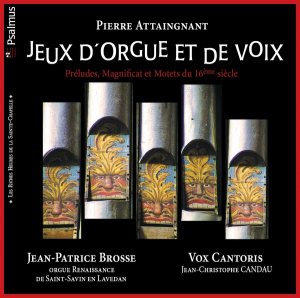 |
 |
|

Support
us financially by purchasing this disc from: |
|
|
|
Pierre Attaingnant - Jeux d'orgue et de voix
anon
Praeludium (organ) [2:29]
Magnificat du 4e ton (organ, plainchant with faux-bourdon)
[12:18]
Prélude aux 13 motets (organ) [1:03]
Jean (Pierre?) DE LAFAGE (LAFARGE?)
(fl. 1518-1530)
Aspice Domine (motet and organ transcription) [7:21]
Mathieu GASCONGNE (before 1502-1552)
Bone Jesu dulcissime (motet and organ transcription) [5:50]
Loyset COMPÈRE (c.1445-1518)
O vos omnes (motet and organ transcription) [6:10]
anon
Kyrie Cunctipotens (organ, plainchant) [6:31]
Prélude aux 13 motets (organ) [1:08]
Jacob OBRECHT (1457/58-1505)
Parce Domine (motet and organ transcription) [4:28]
Antoine DE FÉVIN (c.1470-1511/12)
Sancta Trinitas (motet and organ transcription) [7:56]
Claudin DE SERMISY (c.1490-1562)
Si bona suscepimus (motet and organ transcription) [8:40]
anon
Prélude sur chacun ton (organ) [3:43]
 Jean-Patrice Brosse (organ)
Jean-Patrice Brosse (organ)
Vox Cantoris/Jean-Christophe Candau
(Yann Rolland (superius), Jean-Christophe Candau, Damien Rivière,
Hervé Lamy (tenor), Malcolm Bothwell, Antoine Sicot (bass))
rec. September and November 2011, Abbatiale de Saint-Savin, Lavedan
(Haute-Pyrénées) and Église Saint-Pierre, La
Réole (Gironde), France. DDD
Texts and translations included
 PSALMUS PSAL 015 [67:38]
PSALMUS PSAL 015 [67:38]
|
|
|
The man in the title of this disc, Pierre Attaingnant, was not
a composer but a printer, and a very important one at that.
His first publication dates from 1525 and many followed; when
he died in 1551 the number of volumes printed by Attaingnant
was no fewer than 174. His widow continued his business and
printed seven more books, comprising more than 1,000 pieces.
This disc concentrates on three books with liturgical keyboard
music which were published in 1531. Although he was just a printer,
that doesn't exclude the possibility that he himself contributed
to the form in which the music was published. Many editions
include arrangements, and it is mostly not known who exactly
is responsible for them. One of the volumes from which the music
for this disc is chosen comprises organ transcriptions of motets,
and it may be Attaingnant himself who acted as the arranger.
At the time of publication the organ played an important role
in the liturgy. It had largely three functions which are reflected
in the programme. Firstly, it played preludes which introduced
a motet which was to be sung. Secondly, it was involved in the
performance of liturgical chant, in alternation with the choir.
This disc includes two examples: the Magnificat du 4ème
ton and the Kyrie Cunctipotens. Lastly, the organ
played transcriptions of vocal pieces, especially motets. On
this disc various pieces can be heard in two versions: first
the organ transcription and then the original vocal form.
The word 'transcription' is not quite correct: these pieces
are more than just a literal transposition of the notes of the
various voices to the organ. In the organ version there are
additional notes, in the form of ornaments, and also transitional
passages which link various sections of a motet. In his liner-notes
the director of Vox Cantoris, Jean-Christophe Candau, states
that these transcriptions provide interesting information in
regard to performance practice. "Whereas in singing, the ornamentation
does not appear on the score and is improvised, it is entirely
written out in organ music. We therefore studied the divisions
(ornamentation procedure) and other grace-notes proposed by
Attaingnant to inspire us in our singing and find the soul of
music that exceeds the performer".
There are two aspects of this recording which makes it even
more valuable. Firstly, in the Magnificat du 4ème
ton the vocal verses are performed with faux-bourdons. These
are also from a historical source. "What a pleasant surprise
we had, a few years ago, finding a group of faux-bourdons on
the eight church tones, written carelessly on a few sheets at
the end of a 16th-century collection of some thirty three-part
love songs!". They were written by Jean du Moulin, master of
the children's choir at the church in Sens. The Kyrie Cunctipotens
is taken from the 16th-century Roman gradual Cenomanense
of 1515 which is now in the French National Library. This version
includes tropes, additional texts to the traditional
Kyrie chant.
Another interesting aspect is the choice of the organ. It was
built in 1557 by Antoine Riballier and had eight stops. It was
abandoned during the French Revolution and at the end of the
19th century it was completely ruined. It was not until the
1970s that a restoration was planned, under the instigation
of the renowned organist Xavier Darasse. Between 1994 and 1996
a restoration was carried out by the organ builders Alain Sals
and Charles Henry. The result is a rather small but magnificent
organ that is perfectly suited to the repertoire on this disc.
Its pitch is a=465 Hz and it is tuned in meantone temperament.
The booklet indicates that the recording was made in two different
venues. I assume that the sung items have been recorded in La
Réole. There is no difference in the acoustic amd there
is a complete unity between the organ pieces and the vocal works.
Jean-Patrice Brosse is a specialist in early music and delivers
an excellent account of the organ pieces. The members of Vox
Cantoris, standing in a half circle around the choirbook, adopt
historical pronunciation, in a mostly moderate tempo. They achieve
considerable transparency which allows one to follow the various
lines in the music.
This disc offers a highly fascinating account of the liturgical
practices in early 16th-century France.
Johan van Veen
http://www.musica-dei-donum.org
https://twitter.com/johanvanveen
Note
The booklet gives Pierre de LaFage as the composer's name, in
New Grove (ed. 2003) he is called Jean de LaFarge
Support
us financially by purchasing this disc from: |
|
|
|
|

